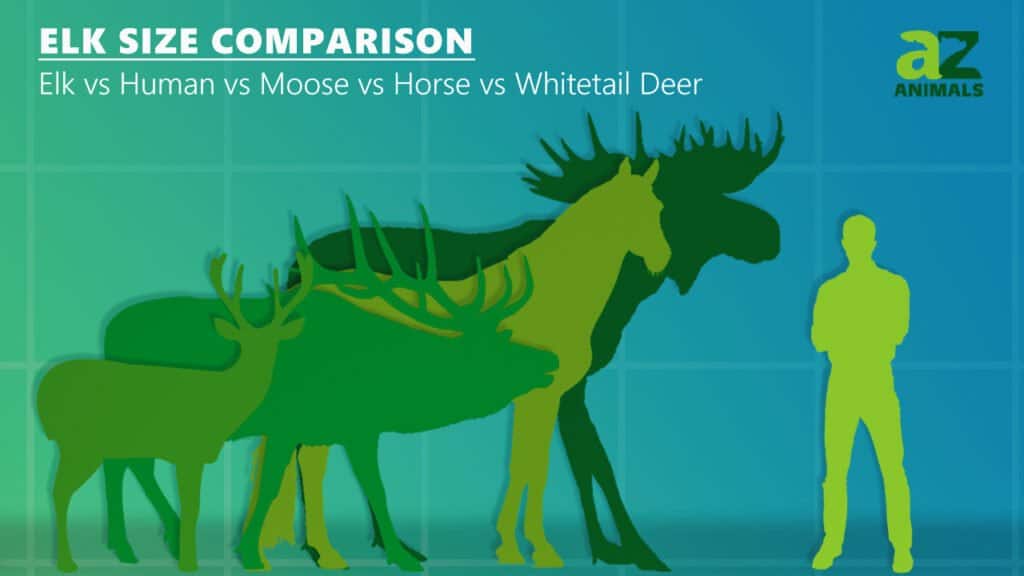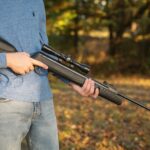At first glance, moose and horses look somewhat similar. They’re both ungulates, or mammals with hooves, walk on four legs, and have a similar body and head shape. That’s about where the similarities end, though.

In the U.S., horses are almost exclusively pets, while moose almost exclusively live in the wild. Male moose have antlers; horses don’t. And while there are a few different species of moose, just like there are many horse breeds, horses are faster while moose are larger. Generally, a moose weighs up to 1,400 pounds (635 kg), while horses typically weigh a maximum of 1,200 (550 kg) pounds.
Here are 11 photos that help showcase the size difference between moose and horses.
Jump to:
- 1. Size Comparison
- 2. There Are Some Exceptions
- 3. A Little Bit Taller
- 4. Just a Bystander
- 5. Different Sizes for Different Climates
- 6. Watch the Road
- 7. Keep a Safe Distance
- 8. Watch Out for the Antlers
- 9. An Aggressive Moose is a Dangerous Moose
- 10. Sometimes, They Get Along Just Fine
- 11. Care to Share?
- Final Thoughts
Table of Contents
- 1. Size Comparison
- 2. There Are Some Exceptions
- 3. A Little Bit Taller
- 4. Just a Bystander
- 5. Different Sizes for Different Climates
- 6. Watch the Road
- 7. Keep a Safe Distance
- 8. Watch Out for the Antlers
- 9. An Aggressive Moose is a Dangerous Moose
- 10. Sometimes, They Get Along Just Fine
- 11. Care to Share?
- Final Thoughts
1. Size Comparison

On average, a moose will be heavier, taller, and longer than a horse. In fact, they’re the largest species in the family Cervidae, which also includes elk and deer.
2. There Are Some Exceptions

While moose are typically larger than horses, there are some horse breeds that have the moose beat. The Shire horse, for example, is one of the largest horse breeds and can greatly outweigh a moose. A stallion Shire horse usually ranges from 1,950-2,400 pounds (900-1100 kg). The largest Shire horse, a gelding named Samson, topped the scales at 3,360 pounds (1,524 kg)!
3. A Little Bit Taller

While the moose is closer to the camera in this photo, it’s still pretty clear that it’s taller than the horse. The average height of a moose at the shoulders is between 4 feet 7 inches (1.3 meters) and 6 feet 11 inches (2.1 meters), while horses, on average, are about five feet tall (1.5 meters).
4. Just a Bystander

Though there have been people throughout history who have managed to domesticate moose, it doesn’t happen often. This moose seems perfectly content to watch his fellow ungulates pull a wagon.
5. Different Sizes for Different Climates

Domesticated horses can be found all over the world today, but modern horses originally came from central Asia. Moose, however, are only found in the wild in the northern parts of North America and Eurasia. They stay warm thanks to their thick fur but also their massive size, which helps their bodies retain heat.
6. Watch the Road

While moose are usually larger, both moose and horses are big enough to cause big problems on the road. Both are typically taller than a sedan, and moose can be as tall as or taller than a pickup truck. While not as common as hitting a deer, there are still about 500 incidents involving moose each year in New England alone. Moose can also do much more damage to vehicles and are more likely to result in fatalities than an accident with a dear.
While it’s much less common to hit a horse, as they don’t often roam free, there are still a handful of incidents each year. They most often happen between October and December and usually on main roads. Things are especially bad in Amish country, where they use horse-drawn carriages instead of vehicles. Pennsylvania calculated that between 2007-2016, there were 633 crashes that involved horses and buggies, with a total of 23 deaths.
To avoid colliding with a moose or horse, use caution when driving through wilderness, farmland, or areas where horse-drawn carriages are common.
7. Keep a Safe Distance

It’s hard to say what would happen if a moose and horse were to meet; there isn’t a lot of research done, and it would depend on the specific horse and moose. However, moose are known to be aggressive at times and, because of their size, can inflict serious damage. If you’re riding your horse and run into a moose, it’s best to keep your distance and get away as quickly and calmly as possible, especially if your horse spooks easily.
8. Watch Out for the Antlers
While the body of a moose is typically going to be taller than the body of a horse, that size difference only grows when you factor in a moose’s antlers. The antlers, which are made of bone, average between four and five feet (1.2-1.5 meters) wide and can weigh between 25 and 30 pounds (11-16.5 kilograms). Only male moose, or bulls, have antlers, and they typically use their antlers to assert dominance.
9. An Aggressive Moose is a Dangerous Moose

Most often, the male moose, or bulls, are the aggressive ones. While moose typically will leave you alone, they can also carry a parasite called a brainworm that increases their aggression. If an angry moose attacks a horse, the moose may fight using its antlers or by kicking with its front hooves. Moose can kick both straight ahead and sideways. Combined with their muscular build, this makes them particularly dangerous in a fight.
10. Sometimes, They Get Along Just Fine

Just because moose are bigger and stronger doesn’t mean they can’t get along with their distant cousins. Blogger and horse trainer Carola Sossdorf adopted an orphaned moose named Emma when the moose was just a few days old. While a female moose is less likely to be aggressive anyway, being raised among other horses likely helped her get used to having horses around.

This photographer managed to snap a photo of a horse and moose sharing a meal, but that doesn’t happen often, in part because the two animals have different dietary needs. Both are herbivores, meaning they exclusively eat plants, but they choose different plants for their diets. Horses typically dine on grass and hay, as well as the oats in horse feed.
Moose, however, typically eat leaves and twigs from woody plants they can find in their natural habitat. Leaving food out for moose is not advised, as offering them food outside of their diet can cause them harm.
Final Thoughts
On average, you’ll find moose to be taller than horses, but there are always exceptions. Part of the reason moose are built to be larger is that their body mass helps them survive in the colder climates they inhabit. Because horses are domesticated in North America, they’re usually more used to being around people. Moose, however, can sometimes become aggressive, so it’s best to avoid them when possible.
Both animals are beautiful creatures with majestic, strong natures. While you can snuggle up to a horse, given the tendencies of moose, it’s best to watch them from a distance.








































